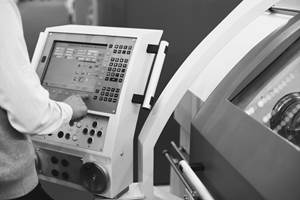Where's The Fault? SWIPE To Find Out
Nobody likes to be the bearer of bad tidings. This goes back to the dawn of recorded history, when a tribal leader might easily decide to kill the messenger if the news was not to his liking.
Nobody likes to be the bearer of bad tidings. This goes back to the dawn of recorded history, when a tribal leader might easily decide to kill the messenger if the news was not to his liking. A modern-day version is to blame your gaging equipment supplier when your quality assurance measurements are not meeting expectations.
If you are sure the parts are good, but the measurements are inconsistent or just plain wrong, or if bad parts are getting past your inspection system, the problem could very well be the gage itself. Since the gage is the messenger, it's the obvious place to start, but it's not necessarily the most logical. Gaging equipment manufacturers should have a good handle on what it takes to control their manufacturing processes to deliver consistent quality.
The better thing to do is step back and look at your measurement system as a whole. It consists of five elements that can be summarized by a single acronym, SWIPE. It stands for standard, workpiece, instrument, people and environment. SWIPE is a handy template to follow, both for initially setting up a manufacturing process and for getting to the source of any measurement problem should one materialize.
Standard: In gaging, a comparative measurement is obtained by comparing workpiece dimensions to established physical standards. These include gage blocks as well as master discs and rings. These standards must be routinely calibrated to ensure that they are even more accurate than the gages they are used to master. These standards should be handled as carefully as gage blocks, because nicks and scratches can be a significant contributor to error.
Workpiece: The measurement process must be appropriate to the workpiece. For example, centerless grinding often imposes a slight three-lobed condition on round parts. Most gages aren't designed to detect this condition and will register the part's average diameter rather than its effective maximum diameter.
What's more, it is dangerous to assume that just because a part feature falls within specified dimensions at one point, it will at all others. No part surface is perfectly round, flat or smooth. When a production process is under control, the amount of variation in roundness, flatness and so on is small enough so all points on the part surface fall within the specified tolerances. If the process is out-of-control, some points may lie outside of tolerances even though the gage indicates that the specific point being measured is in tolerance.
Instrument: In addition to being suitable for the specific workpiece, the gage must be in good condition, properly mastered and capable of holding calibration throughout a reasonable service period. Another thing to think about is how your customer might be measuring the part at the receiving end. You may check bores with an air gage, and your customer may check them with a mechanical gage. The air gage averages peaks and valleys, while the mechanical gage only measures peaks. Neither gage is “wrong,” but the results are not comparable either. This is where friendly or unfriendly disagreements occur.
People: Obtaining consistently good (for example, accurate and repeatable) measurement results is also a people issue. Have they been adequately trained to operate the measurement system and record the results? Are the operators assuming responsibility for proper gage care and maintenance? Checking for looseness, parallelism, nicks and scratches, dirt, rust, and so on is absolutely necessary to ensure system performance. It is only natural to cut corners if you are under pressure. It is also natural, perhaps even inevitable, for corner-cutting to result in a faulty measurement system.
Environment: Several factors in the environment around the gage must be considered. First there are dirt, dust and grease, the leading enemies of consistent, accurate gaging. Then there may be thermal influences from heating/air-conditioning systems, drafts, direct sunlight, nearby machines, a hot workpiece and even the operator's body heat. What about static electricity, magnetism, power surges, RFI/EMI and external movement that may be as obvious as vibrations from a nearby stamping press or as subtle as the water level rising and falling in a river several blocks away from the plant?
So before you kill the messenger, take a look at the total measurement system. Then, if you've done a thorough review and still can't find the problem, call your gaging equipment vendor.
Related Content
How to Choose the Right Cut Off When Measuring Roughness
Measurement results for surface finishing parameters can vary depending on the filter parameter (Lc), also known as the cutoff.
Read MoreOrthopedic Event Discusses Manufacturing Strategies
At the seminar, representatives from multiple companies discussed strategies for making orthopedic devices accurately and efficiently.
Read MoreHelp Operators Understand Sizing Adjustments
Even when CNCs are equipped with automatic post-process gaging systems, there are always a few important adjustments that must be done manually. Don’t take operators understanding these adjustments for granted.
Read MoreHow to Calibrate Gages and Certify Calibration Programs
Tips for establishing and maintaining a regular gage calibration program.
Read MoreRead Next
A History of Precision: The Invention and Evolution of Swiss-Style Machining
In the late 1800s, a new technology — Swiss-type machines — emerged to serve Switzerland’s growing watchmaking industry. Today, Swiss-machined parts are ubiquitous, and there’s a good reason for that: No other machining technology can produce tiny, complex components more efficiently or at higher quality.
Read More3 Mistakes That Cause CNC Programs to Fail
Despite enhancements to manufacturing technology, there are still issues today that can cause programs to fail. These failures can cause lost time, scrapped parts, damaged machines and even injured operators.
Read MoreObscure CNC Features That Can Help (or Hurt) You
You cannot begin to take advantage of an available feature if you do not know it exists. Conversely, you will not know how to avoid CNC features that may be detrimental to your process.
Read More























